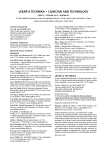REHABILITATION OF PATIENTS USING ACCELEROMETERS: FIRST EXPERIMENTS
In this article, the use of accelerometers for rehabilitation of patients is described. The appropriate rehabilitation process is a key approach to treat a broad range of different diagnoses. The main problem of rehabilitation processes is a subsequent evaluation of their quality to achieve best results. This initial study describes a possibility of using accelerometers for objective evaluation of quality and monitoring the results. The first measurements with accelerometers were conducted on several exercises which are part of the Tinetti balance assessment tool. For these measurements, the 3D MEMS accelerometer implemented in the STM32-Primer2 development kit was used. After the assessment of results obtained on healthy persons, the clinical tests on senior patients will follow.
Keywords:
accelerometer, rehabilitation, Tinetti balance assessment tool, STM32Primer2
Autoři:
Jakub Parak 1; Lucie Talacková 1; Jan Havlik 1; Lenka Lhotská 2
Působiště autorů:
Deparment of Circuit Theory, Faculty of Electrical Engineering, CTU in Prague
1; Deparment of Cybernetics, Faculty of Electrical Engineering, CTU in Prague
2
Vyšlo v časopise:
Lékař a technika - Clinician and Technology No. 2, 2012, 42, 65-68
Kategorie:
Conference YBERC 2012
Souhrn
In this article, the use of accelerometers for rehabilitation of patients is described. The appropriate rehabilitation process is a key approach to treat a broad range of different diagnoses. The main problem of rehabilitation processes is a subsequent evaluation of their quality to achieve best results. This initial study describes a possibility of using accelerometers for objective evaluation of quality and monitoring the results. The first measurements with accelerometers were conducted on several exercises which are part of the Tinetti balance assessment tool. For these measurements, the 3D MEMS accelerometer implemented in the STM32-Primer2 development kit was used. After the assessment of results obtained on healthy persons, the clinical tests on senior patients will follow.
Keywords:
accelerometer, rehabilitation, Tinetti balance assessment tool, STM32Primer2
Zdroje
[1] K. M. Culhane, M. O’Connor, D. Lyons, G. M. Lyons, “Accelerometers in rehabilitation medicine for older adults,” Age Ageing, 2005, vol. 34, no. 6, pp. 556 – 560.
[2] M. Mancini, F. B. Horak, “The relevance of clinical balance assessment tools to differentiate balance deficits,” European Journal of Physical and Rehabilitation Medicine, 2010, vol. 46, no. 2, pp. 239 – 248.
[3] Ren Wang, Hang Guo, Jiashan Xu, W.H. Ko, "A supplementary system based on wireless accelerometer network for rehabilitation," in Proc. 5th IEEE International Conference on Nano/Micro Engineered and Molecular Systems (NEMS), China 2010, pp. 1124 – 1127.
[4] Y. Higashi, M. Sekimoto, F. Horiuchi, T. Kodama, T. Yuji, T. Fujimoto, M. Sekine, T. Tamura, “Monitoring rehabilitation training for hemiplegic patients by using a tri-axial accelerometer,” in Proc. 23rd Annual International Conference of the IEEE Engineering in Medicine and Biology Society, Turkey 2001, vol. 2, pp. 1472 – 1474.
[5] A. Dunne, Son Do-Lenh, G.O. Laighin, Chia Shen, P. Bonato, “Upper extremity rehabilitation of children with cerebral palsy using accelerometer feedback on a multitouch display,” in Proc. Annual International Conference of the IEEE Engineering in Medicine and Biology Society (EMBC), Argentina 2010, pp. 1751 – 1754.
[6] J. Boyle, M. Karunanithi, T. Wark, W. Chan, C. Colavitti, “Quantifying Functional Mobility Progress for Chronic Disease Management,” in Proc. 28th Annual International Conference of the IEEE Engineering in Medicine and Biology Society, USA 2006, pp. 5916 – 5919.
[7] N. Bidargaddi, A. Sarela, L. Klingbeil, M. Karunanithi, “Detecting walking activity in cardiac rehabilitation by using accelerometer,” in Proc. 3rd International Conference on Intelligent Sensors, Sensor Networks and Information, Australia 2007, pp.555 – 560.
[8] Raisonance. (2010, May). STM32-Primer2 User Manual. [Online]. Available: http://www.stm32circle.com/resources/ download.php?STM32-Primer2-Manual.pdf
[9] STMicroelectronis. (2008, January). LIS3LV02DL Datasheet. [Online]. Available: http://www.st.com/internet/com/ TECHNICAL_RESOURCES/TECHNICAL_LITERATURE/D ATASHEET/CD00091417.pdf
[10] Wimar. (2007, March). A USB HID Component for C#. [Online]. Available: http://www.codeproject.com/Articles/ 18099/A-USB-HID-Component-for-C
[11] R. Reznik. (2007, May). Realtime Chart and Graph in One. [Online]. Available: http://www.codeproject.com/Articles/ 15694/Realtime-Chartand-Graph-in-One
[12] M. E. Tinetti, T. F. Williams, R. Mayewski, “Fall Risk Index for elderly patients based on number of chronic disabilities,” American Journal of Medicine, 1986, vol. 80, pp. 429 – 434.
Štítky
BiomedicínaČlánok vyšiel v časopise
Lékař a technika

2012 Číslo 2
Najčítanejšie v tomto čísle
- MECHANICAL MODEL OF THE CARDIOVASCULAR SYSTEM: DETERMINATION OF CARDIAC OUTPUT BY DYE DILUTION
- MATLAB AND ITS USE FOR PROCESSING OF THERMOGRAMS
- The Fifth Biomedical Engineering Conference of Young Biomedical Engineers and Researchers
- VALUATION METHODOLOGY FOR MEDICAL DEVICES
